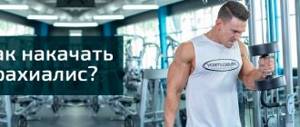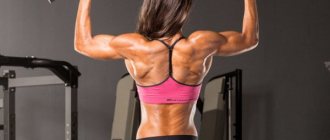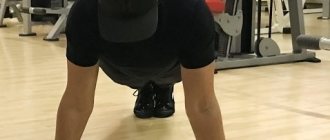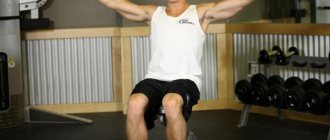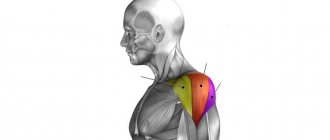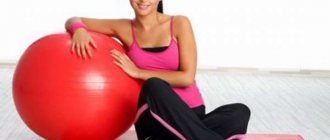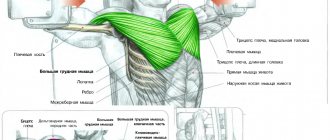TOP 7 types of shoulder push-ups that can pump up muscles + 2 example workouts for home
Hello dear reader!
Today we’ll talk about increasing muscle mass in the shoulder girdle. The deltoids have secured their status as muscles that are difficult to pump. This is due to the fact that it is difficult to “feel” the shoulders and include them in the work. In addition, muscle growth and the amount of testosterone decreases with age, making it more difficult to make shoulders massive. Therefore, for maximum effect, you need to start pumping deltas as early as possible. Massive, broad shoulders are the first thing people around, especially girls, pay attention to. Therefore, shoulder push-ups are a must have for every young guy or adult man. In this article I will tell you about an easy way to gain large muscles using delt push-ups.
What kind of exercise is this
Push-ups are a simple lifting of the torso in a lying position. A special stance is used to engage the deltoid muscles. It is distinguished by a narrow position of the arms and elbows pressed to the body.
In training, variations of this exercise are used, including the front, middle or rear groups of deltas.
What muscles work
With the correct positioning of the body and palms, the upper bundles of deltas are pumped first. In this case we are talking about the anterior and middle deltas. The rear one is involved in the work to a lesser extent.
Other groups are also working on push-ups. This is a universal workout for increasing pectoral muscles, triceps, stabilizers, and endurance.
Benefits and harms
Push-ups, like any exercise, can be useful under certain conditions:
- General strengthening activity. In terms of the number of push-up groups included in the work, they are not inferior to squats and pull-ups on the horizontal bar. It’s not for nothing that they are included in the list of basic bodyweight exercises.
- Stabilizer training. When doing push-ups, you strengthen the muscles responsible for stabilizing your arms and core. Powerful stabilizers are the key to good coordination and strength.
- Press. By doing a lying position, you also use your abdominal and abdominal muscles.
- Body endurance. Push-ups are considered an anaerobic exercise. However, a large number of repetitions and approaches improves the functioning of the cardiovascular system and increases endurance.
- Increased strength. Push-ups can increase the strength of the muscle tissues of the chest and arms in a short time. That is why this exercise is the basis of many army and bodybuilding programs.
Push-ups are considered harmful due to the increased stress on the wrists, which leads to joint-related diseases. Problems will begin if you do not use arm bandages or special cuffs when performing these exercises frequently with weights.
Also, the disadvantages of push-ups include incomplete development of the rear and middle deltas.
Contraindications
There are contraindications for performing push-up exercises while lying down:
- High blood pressure due to body position.
- Diseases of joints and tendons. Push-ups are a multi-joint exercise. Therefore, people with problems in the wrists, elbows and shoulders are contraindicated to perform them.
- Overtraining of the body. You should not overuse push-ups - you will get tired, and catabolism will begin after a large number of approaches.
Is it possible to build bigger shoulders at home with push-ups?
You can and should strengthen your shoulders at home with push-ups. For maximum effect, you need a whole system:
This will allow you to build strong and voluminous deltoids, even if you don’t go to the gym.
Of course, it is difficult to achieve stunning results with basic push-ups. To do this, experienced athletes use isometric types of such training. This allows you to focus the load on a specific group and increase the effectiveness of the exercise.
How to organize training?
Creating your own individual program on how to quickly pump up your shoulders with push-ups is not at all difficult. The following general principles of strength training will help you:
- Start every workout with a warm-up.
- It is worth including all the presented push-up options in one workout to get the maximum effect.
- For muscle growth, it is not the number of repetitions that is important, but their quality. Do not try to do push-ups quickly, helping yourself with the inertia of your body. We must strive to achieve maximum tension in the muscles in extreme positions.
- While maintaining the quality of repetitions, gradually increase their number. For example, you can increase them by 5 every week.
- Exercise 3-4 times a week, alternating training days with rest days: muscles need time to recover.
- Include more protein foods in your diet: without a sufficient amount of building material, muscles will not be able to grow, but will only be depleted.
Sources:
https://fitspine.ru/uprazhnenija/ruki/otzhimanija-na-plechi-kak-nakachat-deltovidnye-myshcy/ https://krasota1zdorove.ru/kak-nakachat-plechi-otzhimaniyami/ https://bodywiki.ru/ plechi/kak-otzhimaniyami-ot-pola-nakachat-plechi.html
Technique and types of exercises
Let's look at three types of the most effective delt push-ups without dumbbells:
- Floor press. A popular option for working out the shoulders. The method is suitable for beginners. Does not require special skills, flexibility or acrobatics. Hands are placed at shoulder level, feet together. It is important to lower your body deeper, until a right angle is formed at the elbow. The disadvantage is the use of the chest and triceps. They will take part of the payload.
- Corner push-ups. Take a lying position and place your feet closer to your hands so that your legs and torso form a right angle. The feet stand on their toes. From this semi-vertical position, begin to do push-ups, lowering yourself along a long amplitude to the floor. In the corner exercise, three bundles of deltoid muscles are involved at once and the load on the arms is reduced. Change the load by changing the distance between your toes and palms.
- Vertical support while lying down. You take the position lying upside down against the wall, palms on the floor. Start doing push-ups, lowering the top of your head to the ground. This type of training is for experienced athletes and requires some acrobatic skills. At the same time, you will feel how the three deltoid bundles work, and you will pump only them. If you want to learn this type of push-up, try standing on your hands against a wall first.
Other types of push-ups do not isolate the shoulders as clearly, but are suitable for pumping up stabilizers:
- Shoulder push-ups. A standard stand is accepted. The amplitude is created by bringing and lowering the shoulder blades without bending the arms.
- Exercises on one leg. To increase the load on your upper body, remove one leg from the stance.
- T-push-ups. When doing push-ups, lift your arms one at a time. At the same time, lift each one up, maintaining the balance of the second. This will further strain the abdominal muscles.
- Reverse push-ups. In this case, the hands are placed on a bench or other elevation, the feet are on the heels. Lower your torso to a right angle between your elbow and forearm. The exercise primarily develops the triceps, but also puts stress on the shoulders.
On topic: Cervical shoulder exercise
Classic technique
Reverse push-ups can be done at home or in the gym. Those who experience discomfort with fully straightened knees can use knee pads or bend their legs slightly so that the main load does not fall on the joint. This will help ensure stability of movement and avoid injury.
At home, you can do the exercise with your hands on the sofa and your feet on a chair. In the exercise room you need to use two benches. We rest our hands on one, the second serves to place our feet on it
The technique is like this:
- We place the benches at a distance of approximately the length of our legs;
- We sit on one of them, rest our palms on the bench so that our hands are at the same distance from the conditional line of the spine. It is better not to place your palms more than 5-7 cm on opposite sides of the sides;
- On the second we place our feet with our heels, bend our knees slightly, and firmly fix our legs;
- We bend our arms at the elbow and shoulder joints at the same time, lower our pelvis down to the level when our forearms become parallel to the floor;
- With an exhalation, we straighten our arms bent at the elbows;
- Repeat a specified number of times
The variation with feet on the floor is suitable for beginners, as well as those who have problems with the position of their legs. With a certain structure of the knee joint ligaments, standing with your heels on a bench may not be comfortable, and even conscious control of the position does not help.
Staging with feet on the floor is different in that the emphasis here should be on the position of the spine, not the legs. Its axis should be strictly perpendicular to the floor, legs bent at the knees approximately 30 degrees away from the bench at a comfortable distance. In this case, the knees can be bent even more if the athlete is tall and cannot otherwise perform the exercise to sufficient depth.
Performing an exercise with a weighted device
It is logical that as training increases, the athlete begins to use weights. This natural process should not be interfered with. Once it becomes easy to do 15 reps of push-ups, muscle failure does not occur, and the movement can continue for minutes, you should stop repeating the same thing and start doing the movement with additional resistance.
Sandbags or barbell plates are used as weights. It is believed that it is more difficult to do with pancakes, since they require the additional inclusion of stabilizer muscles, but this is not true in all cases. Some people find it easier to make with pancakes.
The sandbag lies more stable on the hips; you can take it if your legs are bulky, your quadriceps are stiff and the pancakes “roll off”. You can use other options, for example, placing a person with a small weight on his feet, but this is already extreme.
The technique of performing with weights does not differ from the usual one, you just need to control the weight, for which a stable angle in the hip joints is maintained, and the position of the spine does not change. When it gets hard, a person tends to move his pelvis away from the bench; with weights, this cannot be done without dropping the weight.
Example workout
Below is a sample of exercises at home and in the gym.
At home
It is possible to exercise at home, since training does not require special equipment.
Here is a set of exercises:
- Warm up. To avoid injury, perform warm-up exercises: swing your arms in a circle 10-20 times, raise your arms to the sides 10-20 times, move in a circle with your hands on your shoulders 10-20 times, and at the end, gently stretch your arms and shoulders.
- Shoulder push-ups – 4 to 15 – 30.
- Pushups. Hands shoulder-width apart, elbows close to the body: 4 sets of 6 – 15 push-ups.
- Corner push-ups - 4 sets of 6 - 15 times. Don't forget to adjust the height of the stand.
- Single leg push-ups – 3 x 6 – 12 reps.
- Hitch. At the end, swing your arms: in front of you, to the sides - 3 x 15 - 30 repetitions.
In the gym
When training in the gym, use additional equipment. For example, place your feet on a weight, bench, or ball. This will increase the load on your shoulders.
Also, do barbell squats before working your shoulders. The squat works more muscle groups than any other exercise. By doing it, you will trigger a surge in testosterone, which will have a positive effect on shoulder growth. Perform 3-4 sets of 10 repetitions with medium weight.
Here is a set of exercises:
- Warm up. To warm up, you will need a block trainer or elastic band. Bend your elbow at a right angle. Hold an elastic band or the handle of a block in your palm so that the axis of the load runs parallel to your forearm. Perform hand abduction and abduction - 4 sets of 15-20 repetitions for each arm.
- Shoulder push-ups - 4 sets of 6 - 15.
- Corner push-ups - 4 sets of 6 - 15 times.
- Vertical push-ups or t-push-ups – 4 x 6 – 15 reps.
- On one leg - 3 x 4 - 12 times.
- Hitch. Stretch your arms and deltoids in a butterfly machine or on a bench with dumbbells - 3 x 10-15. Use light weight.
Structure of the shoulder girdle
In order to better understand the exercise technique, it is necessary to have an idea of how this muscle group is structured and functions.
The muscles that form the shoulder girdle are divided into:
- the anterior delta (deltoid muscle), which is responsible for raising the arms forward;
- the middle delta, responsible for raising the arms to the side;
- rear delta, responsible for raising the arms to the sides and back;
- trapezius muscle, which elevates and retracts the shoulder blades.
Training Tips
Having set yourself the goal of having beautiful shoulders, go ahead, but follow some rules.
Sets and reps
Don't chase too many reps. To increase muscle mass and strength, it is better to make the work more difficult as you go. Ideally, do one set of challenging weights at the end of your workout.
The number of repetitions per approach to start the anabolic process is 6 - 15.
Weights
The right option would be to increase the complexity of the approach. To do this, use weights.
For training at home, choose accessories from a sports store. Feel free to take bags or elastic bands in the hall. Don't rush to the gym.
Watch a video of exotic push-up weight training techniques.
Nutrition and sports supplements
Don't forget that training is only a third of success. If you want to pump up your shoulders and build mass, take care of nutrition:
- Eat more protein foods (meat, fish, cottage cheese, eggs, peanuts).
- Use whey protein isolate to give you extra protein every day.
- If you are an ectomorph (prone to thin), I advise you to purchase a gainer as an additional meal.
- To avoid overtraining, consume L-carnitine or BCAA.
What to do if your shoulder hurts when doing push-ups
If your shoulder hurts, it’s worth understanding the nature of the pain’s origin.
- Muscle pain. You have overloaded the muscle. Rest until the fibers recover.
- Joint pain. This is already serious. Pain in the elbows and wrists can be caused by bursitis or arthritis. If this pain persists for weeks, consult your doctor.
What to do if your shoulder hurts after push-ups
It is important to localize sensations:
- If your muscles hurt, most likely you damaged them out of habit during heavy exercise.
- If your bones are bothering you, you should consult a doctor.
Common mistakes
Everyone makes mistakes. It's unpleasant when they affect your health or make your workouts useless.
[expert_bq the main rule when doing push-ups is to lower yourself to 90 degrees at the elbow, feet together, back straight, buttocks in line with your shoulder blades and heels. This is the only way to get the desired effect.[/expert_bq]
Don't rush into complex weights and exercises. Some people start straight away with wide-grip military presses at the gym, but if you're a beginner, master push-ups first. When performing technically difficult exercises, you risk injuring yourself and others.
Conclusion
Push-ups will make your deltoids round and sculpted. You will quickly achieve the desired results if, in addition, you follow a routine, constantly do exercises and monitor your diet. If you are a beginner or do not have access to a gym, delt push-ups and their variations will replace most exercise machines and trainers. Be sporty and healthy!
If you liked the article, subscribe so as not to miss new ones. Tell and share information with your friends on social networks. Thank you for your attention!
Source
The best shoulder exercises at home
Shoulders are an important part of a man's body. The shoulder muscles are very important, they are an indicator of strength and masculinity. To build up your shoulders, you don't have to go to the gym.
Today I will tell you about how to pump up your shoulders at home. We will look at 3 effective exercises that can perfectly pump up your shoulders. The exercises are arranged in order of increasing difficulty. They do not require additional sports equipment and are accessible to everyone.
Corner push-ups.
This exercise is an imitation of a military bench press in the gym. To perform this exercise, you need to lie down and lift your pelvis up so that your body is bent at a right angle.
From this position we begin to perform push-ups. We move our elbows 45 degrees from the body and stretch our heads towards the floor. You can vary the load by moving your legs: the closer your legs are to your hands, the more difficult it is to perform the exercise and the greater the load on your shoulders. Push-ups should be slow and controlled to feel the burning sensation in the muscles. When bending your elbows, inhale; when straightening your arms, exhale.
On topic: Shoulder exercises with a barbell behind your back
Elevated corner push-ups.
After you have mastered corner push-ups, you can move on to the next variation of this exercise. These are more difficult push-ups. To perform them, you will need a hill on which to place your feet. This could be a chair, stool, sofa. We perform the exercise with the same technique, observing breathing.
Handstand push-ups against a wall.
I advise you to start doing these push-ups after studying the first two exercises. This exercise is the most difficult of those given in the article. Handstand push-ups will give you maximum shoulder awareness.
Facing the wall, stand on your hands with your feet on the wall. Use your feet to maintain balance. Lower yourself, spreading your elbows to the sides to an angle of 90 degrees, and rise to the starting position. When lowering, inhale; when straightening your arms, exhale.
The given exercises effectively affect the shoulder muscles. I use them often in my workouts and hope they help you build muscle. Perform them efficiently and monitor the position of your body. Do a small number of repetitions, but with the correct technique, and then you will see results. If you do the exercises incorrectly, you can get injured. Therefore, you need to move from simple to complex.
If the article was useful and informative, please like and subscribe to the channel
—
SUBSCRIBE
so as not to miss important information in the field of fitness and sports.
Source
How to do push-ups to pump up your shoulders?
The impact on the shoulder muscles in push-ups will be maximized when using several variations of this exercise.
Today there are several modifications that will allow you to maximally load the deltas. To quickly pump and develop the shoulder muscles, you should adhere to the following rules:
- Tension is an important factor for muscle fiber growth. When performing the exercise, try to give maximum load.
- Perform exercises with proper technique if you do not want to get injured.
- Movements should be measured, without haste.
- It is important to ensure proper breathing, especially when performing the exercise upside down.
In the Greek army, the main element of military training was push-ups!
The technique of delt push-ups must be correct; even with a small number of repetitions, the result will be better than if performed incorrectly in a large number.
- The risk of injury increases when the body shifts or the arms are positioned incorrectly.
- If during the process you feel discomfort, then it is better to stop practicing.
How to pump up your shoulders with push-ups at home?
Many novice athletes are wondering how to pump up their shoulders with push-ups at home, and is it even possible? First you need to understand the technique and anatomy of the exercise and its variations, after which you can find the answer to this question.
If you want to practice at home without purchasing special equipment, read the article carefully and draw the right conclusion. Let’s say right away that we have nothing against push-ups, since we consider them an excellent functional exercise for developing the whole body. But are they really that good for pumping up your shoulders?
Types of push-ups
To increase the volume of the deltoid muscles, 2 main types of push-ups are ideal.
The first option is how to pump up your shoulders with push-ups: it can be called “house push-ups.” To perform it, take your usual lying position, but at the same time move your legs closer to your hands. Your legs and body should form a right angle (that’s why this type of exercise is called a “house”). The feet are supported on the toes.
When you have accepted this position, you can proceed to the execution itself. As always, we lower ourselves to the floor with our whole body, after each repetition we do not throw our body, but smoothly return to the starting position. Do the required number of repetitions per set... Many people recommend doing push-ups to failure, in their opinion, this is the most effective way to pump up your shoulders.
Can you get really big shoulders at home with push-ups?
Developing the large shoulder muscles requires commitment to a strength training plan that includes several types of exercises. Push-ups work your shoulders and chest muscles, strengthening your entire upper body. However, doing push-ups alone will not help you achieve maximum shoulder growth results. Push-ups primarily work the pectoral muscles. And the deltoids and triceps muscles are the secondary engines in push-ups. Push-ups increase the size and strength of your deltoids, making your shoulders appear wider.
Push-ups are performed in several variations, each with a different impact on the shoulders. Below are modifications of the exercises and the muscles involved. You will learn how to pump up your shoulders at home with push-ups. But there is a huge disadvantage to these workouts - with push-ups you can pump up the anterior deltoid to a greater extent. If you can easily do push-ups upside down, you can also pump up the middle fascicles of your shoulder. But the rear delt is not included in any of the push-up variations. Therefore, why develop your shoulders unevenly. Push-ups can only become an addition for the deltoid muscles in home workouts to the main complex with weights, but cannot replace a full-fledged program for the deltoids.
Since push-ups are bodyweight work, you won't be able to add additional stress like you should when working to increase muscle mass. Consequently, your strength and the number of repetitions you perform will increase. This will not help you get bigger shoulders. The number of repetitions should start from 8 to 12. If you do a lot more push-ups, then you will only increase endurance, but not volume. You can pump up your shoulders with push-ups at home, but only if you work with both dumbbells and a barbell.
Training programs for the pectoral muscles in tables
It is possible to develop chest muscles well with regular exercise and with a timely increase in loads. There are many different training programs. It should be selected depending on the person’s health, weight, height, and goals. You can learn them from professional trainers or find them on the Internet. We will look at simple programs suitable for beginners of average height and weight in normal health.
Push-up chart for developing the upper thoracic muscles
Push-up table for developing the lower chest muscles
Push-up table for mid-muscle development
Breasts
Once you are able to perform these programs with ease, you need to do the following:
- Add or replace more complex types of exercises. For example, add push-ups on your fingers and with clap to classic push-ups.
- Use weights with a gradual increase in their weight.
- Add exercises with dumbbells, on machines, with a barbell to develop the muscles of the thoracic region.
Perform the exercises according to the programs presented above, or select your own. The main thing is to do them correctly, regularly and gradually increase the load. All of them develop not only the muscles of the thoracic region, but also others, and also strengthen the health of the entire body. As Edward Stanley said: “Those who cannot find time to exercise will have to find time to be sick!”
How to pump up your shoulders with push-ups?
Let's look at how to pump up your shoulders with push-ups, working mainly with the front and middle beams.
It is important! Carefully monitor your body position when performing push-ups to increase the size of your chest and shoulders. Doing a small number of high-quality push-ups is a more effective way to train at home, as opposed to doing a large set of push-ups with poor technique. Using incorrect arm position or misalignment of the hips and back can result in injury. Stop immediately if push-ups cause severe pain or damage your joints. Consult a personal trainer to make sure you are doing everything right.
Upside down push-ups against a wall
This technique will show you how to do push-ups to pump up your shoulders. This is a difficult way to train at home, as it requires preparation for physical activity and control of the whole body. The exercise is performed in a vertical stance against a wall.
- Perform a handstand with your hands wide apart. Touch the wall with your feet for support;
- As you inhale: lower your head to the floor, bending your elbows to the sides, bringing the angle at your elbows to 90 degrees;
- As you exhale: push up with the strength of your arms, returning to straight arms.
- Do not perform more than 12 repetitions. After resting, repeat 3 more sets.
Semi-vertical push-ups
A simplified version of vertical push-ups pumps the front muscles and reduces compression in the shoulder joints. It is performed by raising the feet above the body using a bench or chair, in which the body reaches an inclination of 50 degrees.
- Place your feet on a bench, palms on the floor wider than your shoulders;
- Inhale: lower your chest to the floor, bending your elbows to the sides at a right angle;
- Exhale: push up to the starting point.
On the subject: Shoulder muscle strain in a dog
Corner push-ups
This push-up variation works the front and middle deltoid muscles. The corner technique is a modification of vertical push-ups, and lightens the load by reducing body weight and supporting the legs on a hill. Do not forget to breathe correctly; exhalation is always done with effort.
- Place your feet on a bench, chair or bed, palms wide apart on the floor;
- Move your hands closer to your legs, drawing a right angle between your torso and the berms. Pelvis over shoulders;
- Inhale: bend your elbows, moving them to the sides, your head tends, but does not touch the floor;
- Exhale: do push-ups with your arms straight.
Narrow push-ups
In this option, only the front deltas are trained. You can perform push-ups from the floor or with your palms on a bench - this option will simplify the technique with greater tension in the chest and triceps muscles.
- Place your palms under your shoulders in a prone position;
- Inhale: lower your chest to the floor, bending your elbows along your torso;
- Exhale: using the strength of your arms and chest, push yourself to the original position.
Reverse push-ups
This technique will show how to pump up your shoulders with push-ups if you don’t have special weights. Push-ups work the chest, shoulders and triceps, or more precisely the front deltoids.
- With your back to the bench, place your palms on the edge under your shoulders;
- The knees can be bent; to make it more difficult, the legs can be straight, with the heels touching the floor;
- Inhale: bending your arms, elbows go back, taking an angle of 90 degrees;
- Exhale: push off and rise with effort, leaving your pelvis hanging.
What types of delt push-ups are there?
Unfortunately, there are not many push-up techniques for broadening the shoulders and they all require some preparation. You can begin to implement them only if you are confident in your abilities.
Little house
This technique is great for working the front and middle deltas, increasing their strength and volume. The load is eased by reducing body weight and creating additional support for the legs. Among the techniques presented, everyone can choose the best push-ups for shoulders and decide what they need.
Technique:
- We take a lying position, lifting our buttocks up, forming a 90-degree angle between the body and legs.
- To do this, we gradually bring our hands closer to our feet, resting on our toes.
- The pelvis is located above the shoulders.
- As you inhale, we move and bend your elbows to the side, lower yourself to the floor as far as possible, and as you exhale, we rise up, straightening your arms.
